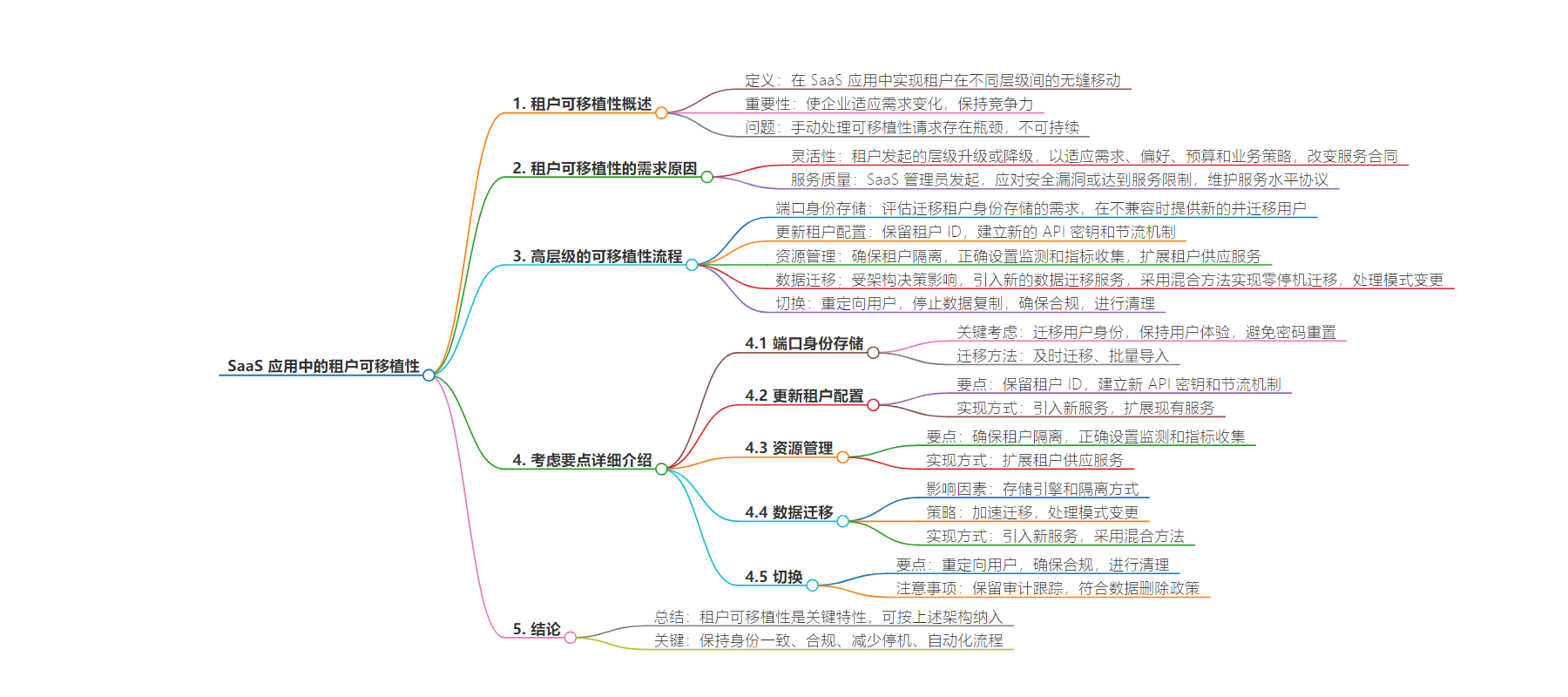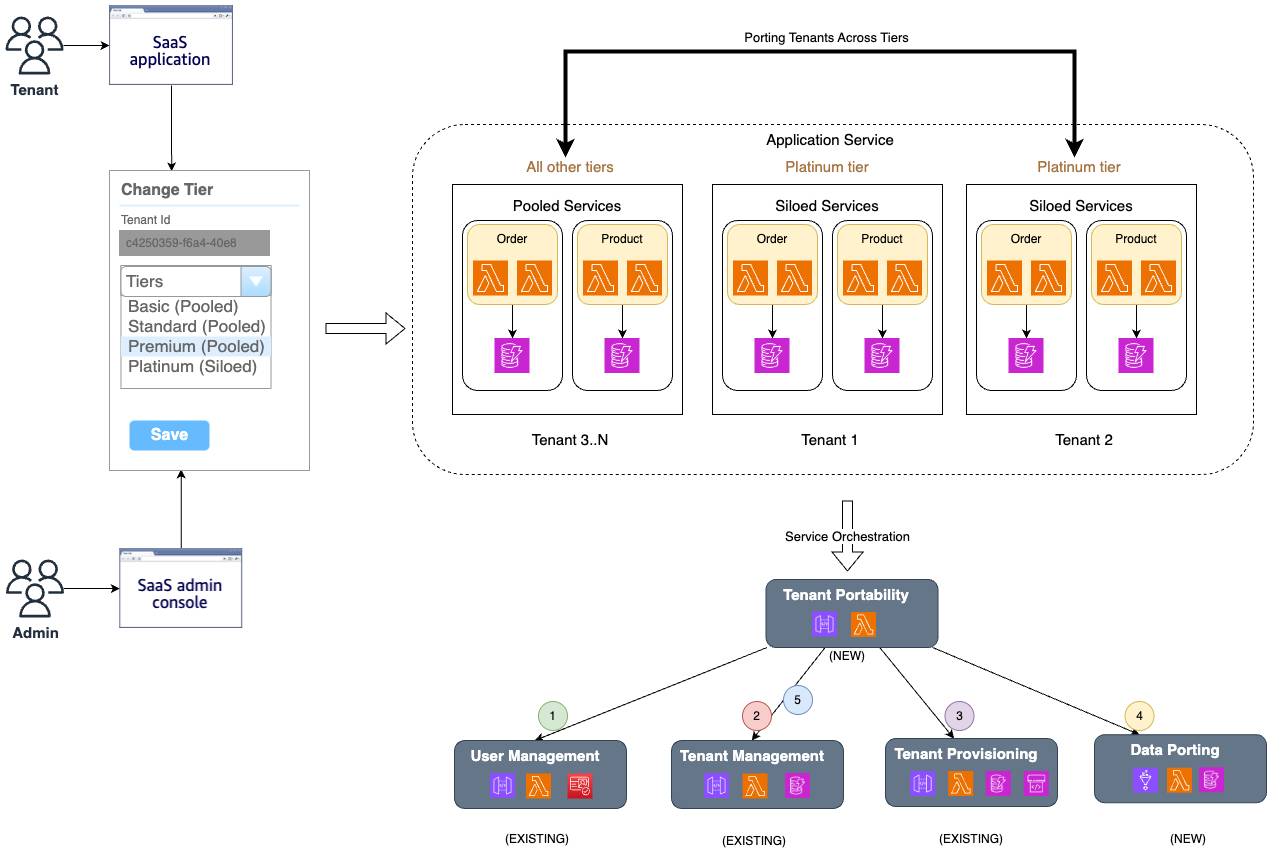包阅导读总结
1. 关键词:Tenant Portability、SaaS、Tier Movement、Identity Store、Data Migration
2. 总结:本文探讨了 SaaS 应用中租户可移植性的重要性,包括其意义、流程步骤及关键考虑因素,强调了实现无缝集成的方法和需解决的问题,以确保租户能在不同层级间顺利迁移。
3. 主要内容:
– Tenant Portability 的重要性
– 帮助 SaaS 提供商保持竞争力
– 使企业适应需求变化
– 手动处理请求存在瓶颈
– 为何需要租户可移植性
– 灵活性:适应客户需求、预算和策略
– 服务质量:应对安全问题和服务限制
– 高级可移植性流程
– 端口身份存储
– 更新租户配置
– 资源管理
– 数据迁移
– 切换
– 考虑事项演练
– 端口身份存储:迁移用户身份,维持用户体验
– 更新租户配置:保留租户 ID,建立新 API 密钥和节流机制
– 资源管理:确保租户隔离和正确设置监测
– 数据迁移:根据架构决策选择策略,处理模式变更
– 切换:重定向用户,确保合规,进行清理
– 结论
– 可移植性是多租户 SaaS 的重要特性,需考虑关键因素并自动化流程
思维导图:
文章来源:aws.amazon.com
作者:Aman Lal
发布时间:2024/8/7 10:12
语言:英文
总字数:1186字
预计阅读时间:5分钟
评分:86分
标签:SaaS,租户可移植性,无服务器架构,AWS 服务,数据迁移
以下为原文内容
本内容来源于用户推荐转载,旨在分享知识与观点,如有侵权请联系删除 联系邮箱 media@ilingban.com
In today’s fast-paced software as a service (SaaS) landscape, tenant portability is a critical capability for SaaS providers seeking to stay competitive. By enabling seamless movement between tiers, tenant portability allows businesses to adapt to changing needs. However, manual orchestration of portability requests can be a significant bottleneck, hindering scalability and requiring substantial resources. As tenant volumes and portability requests grow, this approach becomes increasingly unsustainable, making it essential to implement a more efficient solution.
This blog post delves into the significance of tenant portability and outlines the essential steps for its implementation, with a focus on seamless integration into the SaaS serverless reference architecture. The following diagram illustrates the tier change process, highlighting the roles of tenants and admins, as well as the impact on new and existing services in the architecture. The subsequent sections will provide a detailed walkthrough of the sequence of events shown in this diagram.

Figure 1. Incorporating tenant portability within a SaaS serverless reference architecture
Why do we need tenant portability?
- Flexibility:Tier upgrades or downgrades initiated by the tenant help align with evolving customer demand, preferences, budget, and business strategies. These tier changes generally alter the service contract between the tenant and the SaaS provider.
- Quality of service: Generally initiated by the SaaS admin in response to a security breach or when the tenant is reaching service limits, these incidents might require tenant migration to maintain service level agreements (SLAs).
High-level portability flow
Tenant portability is generally achieved through a well-orchestrated process that ensures seamless tier transitions. This process comprises of the following steps:

Figure 2. High-level tenant portability flow
- Port identity stores: Evaluate the need for migrating the tenant’s identity store to the target tier. In scenarios where the existing identity store is incompatible with the target tier, you’ll need to provision a new destination identity store and administrative users.
- Update tenant configuration: SaaS applications store tenant configuration details such as tenant identifier and tier that are required for operation.
- Resource management: Initiate deployment pipelines to provision resources in the target tier and update infrastructure-tenant mapping tables.
- Data migration: Migrate tenant data from the old tier to the newly provisioned target tier infrastructure.
- Cutover: Redirect tenant traffic to the new infrastructure, enabling zero-downtime utilization of updated resources.
Consideration walkthrough
We’ll now delve into each step of the portability workflow, highlighting key considerations for a successful implementation.
1. Port identity stores
The key consideration for porting identity is migrating user identities while maintaining a consistent end-user experience, without requiring password resets or changes to user IDs.
Create a new identity store and associated application client that the frontend can use; after that, we’ll need a mechanism to migrate users. In the reference architecture using Amazon Cognito, a silo refers to each tenant having its own user pool, while a pool refers to multiple tenants sharing a user pool through user groups.
To ensure a smooth migration process, it’s important to communicate with users and provide them with options to avoid password resets. One approach is to notify users to log in before a deadline to avoid password resets. Employ just-in-time migration, enabling password retention during login for uninterrupted user experience with existing passwords.
However, this requires waiting for all users to migrate, potentially leading to a prolonged migration window. As a complementary measure, after the deadline, the remaining users can be migrated by using bulk import, which enforces password resets. This ensures a consistent migration within a defined timeframe, albeit inconveniencing some users.
2. Update tenant configuration
SaaS providers rely on metadata stores to maintain all tenant-related configuration. Updates to tenant metadata should be completed carefully during the porting process. When you update the tenant configuration for the new tier, two key aspects must be considered:
- Retain tenant IDs throughout the porting process to ensure smooth integration of tenant logging, metrics, and cost allocation post-migration, providing a continuous record of events.
- Establish new API keys and a throttling mechanism tailored to the new tier to accommodate higher usage limits for the tenants.
To handle this, a new tenant portability service can be introduced in the SaaS reference architecture. This service assigns a different AWS API Gateway usage plan to the tenant based on the requested tier change, and orchestrates calls to other downstream services. Subsequently, the existing tenant management service will need an extension to handle tenant metadata updates (tier, user-pool-id, app-client-id) based on the incoming porting request.
3. Resource management
Successful portability hinges on two crucial aspects during infrastructure provisioning:
- Ensure tenant isolation constructs are respected in the porting process through mechanisms to prevent cross-tenant access. Either role-based access control (RBAC) or attribute-based-access control (ABAC) can be used to ensure this. ABAC isolation is generally easier to manage during porting if the tenant identifier is preserved, as in the previous step.
- Ensure instrumentation and metric collection are set up correctly in the new tier. Recreate identical metric filters to ensure monitoring visibility for SaaS operations.
To handle infrastructure provisioning and deprovisioning in the reference architecture, extend the tenant provisioning service:
- Update the tenant-stack mapping table to record migrated tenant stack details.
- Initiate infrastructure provisioning or destruction pipelines as needed (for example, to run destruction pipelines after the data migration and user cutover steps).
Finally, ensure new resources comply with required compliance standards by applying relevant security configurations and deploying a compliant version of the application.
By addressing these aspects, SaaS providers can ensure a seamless transition while maintaining tenant isolation and operational continuity.
4. Data migration
The data migration strategy is heavily influenced by architectural decisions such as the storage engine and isolation approach. Minimizing user downtime during migration requires a focus on accelerating the migration process, maintaining service availability, and setting up a replication channel for incremental updates. Additionally, it’s crucial to address schema changes made by tenants in a silo model to ensure data integrity and avoid data loss when transitioning to a pool model.
Extending the reference architecture, a new data porting service can be introduced to enable Amazon DynamoDB data migration between different tiers. DynamoDB partition migration can be accomplished through multiple approaches, including AWS Glue, custom scripts, orduplicating DynamoDB tablesandbulk-deleting partitions. We recommend a hybrid approachto achievezero-downtime migration. This solution applies only when the DynamoDB schema remains consistent across tiers. If the schema has changed, a custom solution is required for data migration.
5. Cutover
The cutover phase involves redirecting users to the new infrastructure, disabling continuous data replication, and ensuring that compliance requirements are met. This includes running tests or obtaining audits/certifications, especially when moving to high-sensitivity silos. After a successful cutover, cleanup activities are necessary, including removing temporary infrastructure and deleting historical tenant data from the previous tier. However, before deleting data, ensure that audit trails are preserved and compliant with regulatory requirements, and that data deletion aligns with organizational policies.
Conclusion
In conclusion, portability is a vital feature for multi-tenant SaaS. It allows tenants to move data and configurations between tiers effortlessly and can be incorporated in reference architecture as above. Key considerations include maintaining consistent identities, staying compliant, reducing downtime and automating the process.
